
How to Grow Soybean Seeds
Grow Guide #2486
Family: Fabaceae
Binomial name: Glycine max
Life Cycle: Annual
This 'How to Grow' guide details everything a home gardener needs to know to plant, grow and care for Soybeans (Glycine max).
When to Sow Soybean Seeds
Soybean is a warm season crop that requires warm soil to germinate and a long growing season. Use the table below to identify the best time of year to sow soybean seeds in your climate.
| JAN | FEB | MAR | APR | MAY | JUN | JUL | AUG | SEP | OCT | NOV | DEC | |
|---|---|---|---|---|---|---|---|---|---|---|---|---|
| Cool | ||||||||||||
| Temperate | ||||||||||||
| Sub-Tropical | ||||||||||||
| Tropical | ||||||||||||
| Arid |
Preparation
Soybean plants are best grown in full sun. Choose a location that will receive at least 6 hours of full sun each day.
Soybean plants need a well drained soil enriched with plenty of organic matter. Prepare soil by weeding it thoroughly, digging it over to loosen it and adding aged animal manure or compost. Keep the area free of weeds until planting. Learn more about preparing soil for planting here.
How to Sow Soybean Seeds
Soybean seeds do not require any treatment (eg soaking, stratification) before sowing.
Soybean seeds grow best when they are sown directly into the garden.
- Sow seeds directly in the garden 20mm deep and 15cm apart, with rows 50cm apart.
- Keep soil moist but never wet or dry.
- Seeds should germinate in around 7-14 days at a soil temperature of 25-30°C.
- Young seedlings will need protection from pests, pets and weather until they are established.
Soybean is a tender crop that’s sensitive to frost. Do not transplant seedlings or sow seeds outside until all danger of frost has passed.
How to Grow Soybean
Soybean plants may need watering during the growing season. Water when the soil is dry about 5cm below the surface (test this by scratching away a little soil with your finger). Water deeply in the early morning or late afternoon. Avoid watering the leaves of plants to avoid fungal diseases. Learn more about watering here.
If soil was well prepared no extra fertiliser should be necessary. In poor soil or to give your plants an extra boost, application of a balanced fertiliser or one formulated for fruit and vegetables can be beneficial:
- Apply slow release fertiliser at the recommended rate when transplanting or when seedlings are 5-10cm tall.
- Apply liquid fertiliser at the recommended rate and frequency while plants are fruiting or flowering.
How to Harvest Soybeans
Soybeans should be ready to harvest in approximately 85 days.
Soybean pods must be cooked or fermented prior to eating. The pods are inedible. Harvest pods by cutting with snips/secateurs. Harvest regularly to encourage more pods. For short term storage, harvested bean pods can be kept in a perforated plastic bag in the fridge. For long term storage pods can be fermented or frozen.
Common Problems when Growing Soybeans
Like all plants, soybean is susceptible to some pests, diseases and other problems. Below is a list of the most common problems gardeners encounter when growing soybean plants:
 Aphids are small (2-4mm long) sap-sucking insects that congregate on the new shoots or the undersides of leaves. They can cause leaves to wilt or become discoloured, and also excrete honeydew which can attract ants and other insect pests. To manage aphids, remove them by spraying with a garden hose, apply a soap or alcohol spray, or encourage predatory insects to your garden. Read more about aphids here.
Aphids are small (2-4mm long) sap-sucking insects that congregate on the new shoots or the undersides of leaves. They can cause leaves to wilt or become discoloured, and also excrete honeydew which can attract ants and other insect pests. To manage aphids, remove them by spraying with a garden hose, apply a soap or alcohol spray, or encourage predatory insects to your garden. Read more about aphids here..jpg) Tough pods, peas or beans is usually caused by harvesting the pods when they are too large. Harvest pods when they are firm and large enough to eat but still young and tender; harvesting pods while they are small will also encourage the production of more pods resulting in a larger harvest.
Tough pods, peas or beans is usually caused by harvesting the pods when they are too large. Harvest pods when they are firm and large enough to eat but still young and tender; harvesting pods while they are small will also encourage the production of more pods resulting in a larger harvest.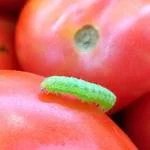 Armyworms, cutworms and other caterpillars can all eat the inside of fruit, making it inedible. Young caterpillars burrow into soft fruit, leaving just a small telltale hole on the fruit’s skin. Monitor fruit and remove any caterpillars you see. If necessary use insect exclusion netting or fruit bags to physically protect the fruit, or spray with Dipel.
Armyworms, cutworms and other caterpillars can all eat the inside of fruit, making it inedible. Young caterpillars burrow into soft fruit, leaving just a small telltale hole on the fruit’s skin. Monitor fruit and remove any caterpillars you see. If necessary use insect exclusion netting or fruit bags to physically protect the fruit, or spray with Dipel.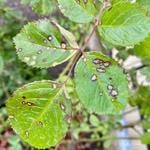 Bacterial leaf spot is a disease that causes irregularly shaped brown spots on all above-ground parts of a plant. The spots at first appear to be wet but become dry and scab-like over time. Leaves and flowers can fall prematurely. Water plants at soil level (not on the leaves), dispose of fallen leaves and fruit and practice crop rotation.
Bacterial leaf spot is a disease that causes irregularly shaped brown spots on all above-ground parts of a plant. The spots at first appear to be wet but become dry and scab-like over time. Leaves and flowers can fall prematurely. Water plants at soil level (not on the leaves), dispose of fallen leaves and fruit and practice crop rotation.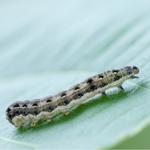 Cutworms are moth larvae that live in the soil, emerging at night to feed. The caterpillars are 3-4cm long and white, grey or brown in colour. They can chew through the stems of tender seedlings, felling them at ground level. Remove cutworms by hand at night or use cardboard collars to protect the stems of seedlings.
Cutworms are moth larvae that live in the soil, emerging at night to feed. The caterpillars are 3-4cm long and white, grey or brown in colour. They can chew through the stems of tender seedlings, felling them at ground level. Remove cutworms by hand at night or use cardboard collars to protect the stems of seedlings.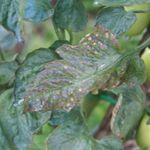 Downy mildew is a fungal disease that causes yellow to grey-brown patches on leaves, especially the undersides. Water plants at soil level (not on the leaves), remove and destroy affected leaves and do not overcrowd plants to ensure adequate air flow. If problems persist, spray with a homemade milk spray or fungicide.
Downy mildew is a fungal disease that causes yellow to grey-brown patches on leaves, especially the undersides. Water plants at soil level (not on the leaves), remove and destroy affected leaves and do not overcrowd plants to ensure adequate air flow. If problems persist, spray with a homemade milk spray or fungicide.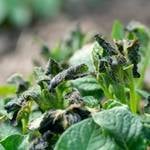 Frost damage can cause leaves to wilt and go black. Do not plant seedlings in the garden until all danger of frost has passed in spring, and harvest plants before winter. Prune all frost-damaged leaves to avoid them rotting on the plant.
Frost damage can cause leaves to wilt and go black. Do not plant seedlings in the garden until all danger of frost has passed in spring, and harvest plants before winter. Prune all frost-damaged leaves to avoid them rotting on the plant. Possums, birds and other animals can ruin a large percentage of your harvest overnight. Physically exclude pests by using netting or cages, or try spraying plants with a pungent homemade spray made from garlic, fish oil or mustard.
Possums, birds and other animals can ruin a large percentage of your harvest overnight. Physically exclude pests by using netting or cages, or try spraying plants with a pungent homemade spray made from garlic, fish oil or mustard..jpg) Powdery mildew is caused by fungal spores reproducing on the leaves of plants. First showing as white spots on leaves, affected areas can spread quickly to cover the entire leaf surface. While rarely fatal, powdery mildew can reduce yields. Water plants at soil level (not on leaves) to prevent spreading spores, allow good air flow between plants, remove affected leaves and if necessary spray with an appropriate fungicide or homemade spray. Read more here about powdery mildew here.
Powdery mildew is caused by fungal spores reproducing on the leaves of plants. First showing as white spots on leaves, affected areas can spread quickly to cover the entire leaf surface. While rarely fatal, powdery mildew can reduce yields. Water plants at soil level (not on leaves) to prevent spreading spores, allow good air flow between plants, remove affected leaves and if necessary spray with an appropriate fungicide or homemade spray. Read more here about powdery mildew here.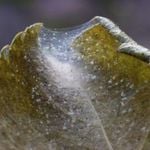 Spider mites (Tetranychus urticae), also known as two spotted mites, are sap-sucking arachnids that cause dry, wilted or discoloured leaves. The undersides of leaves may feel dry and a little like fine sandpaper. Prune plants to allow good air flow or spray with eco-oil or wettable sulphur. Learn more about managing spider mites here.
Spider mites (Tetranychus urticae), also known as two spotted mites, are sap-sucking arachnids that cause dry, wilted or discoloured leaves. The undersides of leaves may feel dry and a little like fine sandpaper. Prune plants to allow good air flow or spray with eco-oil or wettable sulphur. Learn more about managing spider mites here.


.png)



